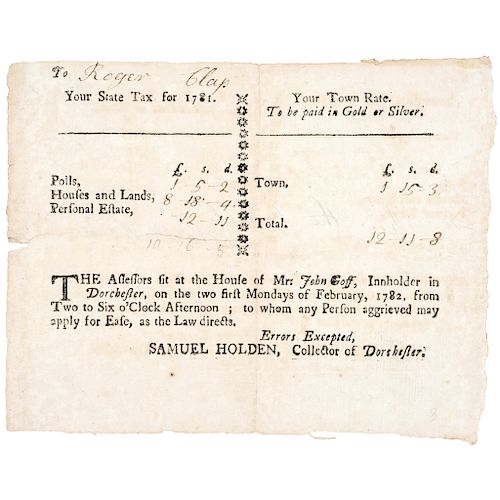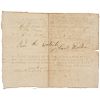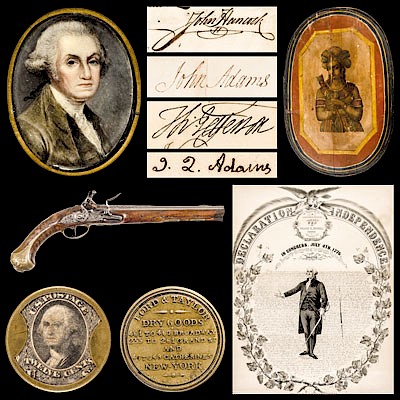1781 Roger + Lemuel Clap House, Revolutionary War Dorchester Tax Collectors Form
Lot 159
Estimate:
$1,800 - $2,400
Absentee vs Live bid
Two ways to bid:
- Leave a max absentee bid and the platform will bid on your behalf up to your maximum bid during the live auction.
- Bid live during the auction and your bids will be submitted real-time to the auctioneer.
Bid Increments
| Price | Bid Increment |
|---|---|
| $0 | $10 |
| $200 | $20 |
| $300 | $25 |
| $500 | $50 |
| $1,000 | $100 |
| $2,000 | $200 |
| $3,000 | $250 |
| $5,000 | $500 |
| $10,000 | $1,000 |
| $20,000 | $2,000 |
| $30,000 | $2,500 |
| $50,000 | $5,000 |
| $100,000 | $10,000 |
| $200,000 | $20,000 |
| $300,000 | $25,000 |
| $500,000 | $50,000 |
About Auction
By Early American History Auctions
Jun 1, 2019
Set Reminder
2019-06-01 12:00:00
2019-06-01 12:00:00
America/New_York
Bidsquare
Bidsquare : Historic Autographs, Colonial Currency, Political Americana & Revolutionary War Era
https://www.bidsquare.com/auctions/early-american-history-auctions/historic-autographs-colonial-currency-political-americana-revolutionary-war-era-4152
Historic Autographs, Coins, Currency, Political, Americana, Historic Weaponry and Guns, John Adams, Thomas Jefferson, Early American History Auctions auctions@earlyamerican.com
Historic Autographs, Coins, Currency, Political, Americana, Historic Weaponry and Guns, John Adams, Thomas Jefferson, Early American History Auctions auctions@earlyamerican.com
- Lot Description
American Revolution
Roger & Lemuel Clap House of Dorchester (Mass.) Historic 1781 Revolutionary War Tax Collector Assessors Tax Form
c. 1781-82 Dated Revolutionary War, Roger & Lemuel Clap House of Dorchester (Mass.), Partially-Printed Document Signed, "Saml. Holden" as Tax Collector on reverse in receipt of funds, and in Signed Type, "Samuel Holden, State and Town Tax Collector of Dorchester," specifically "To be paid in Gold or Silver." 1 page, about 5.75" x 4.5", Choice Very Fine.
The Roger & Lemuel Clap House, which is located to the left rear area of the Dorchester Historical Society property on Boston Street, was acquired by the Dorchester Historical Society in 1946, along with the William Clapp House. The Roger & Lemuel Clap House was remodeled to its present appearanceby Lemuel Clap in the 1760s. Illustrative of mid-18th-century rural architecture, it is listed on the National Register of Historic Places.
Captain Roger Clapp (also spelled Clap) (1609-1690), came to the New World on the ship Mary and John, which landed at Nantasket (now Hull, Massachusetts), on May 30, 1630. He helped establish the town of Dorchester, Massachusetts, soon afterward. He worked for many years in important positions for the town and in the military organization, including a long period as Commandant of Castle Island. The historic Roger Clap House (also spelled Clapp), 199 Boston Street (moved from 25 Willow Court), Dorchester, Suffolk County, MA. is now part of a Historic American Buildings Survey/Historic American Engineering Record/Historic American Landscapes Survey and American Memory as documented after 1933. Library of Congress Prints and Photographs Division Washington, D.C..
It later became known as the "Lemuel Clap House," (originally built probably in 17th century, rebuilt 1760s). Its Photograph is online as it is currently owned and operated by the Dorchester Historical Society, "Stewards of yesterday: collecting, preserving and sharing Dorchester history." Lemuel Clapp served as a Captain during the Revolutionary War, and during the Siege of Boston and the Dorchester Heights Campaign some of his men were stationed in this house. His company was on duty for several of its first years at Dorchester Heights, Noddle's Island, and other places nearby. The Dorchester Historical Society, and other online searches have an extensive information specific to this House and the Clap family.
This 1781 Revolutionary War Dated Tax Form is boldly printed and easily readable, being an original Tax Calculation Bill made to "Roger Clap," for State and Town taxes in 1781 for Polls, Houses and Lands and Personal Estate. Though requiring payment, "To be paid in Gold or Silver." it is doubtful anyone had such hard money assets for payment. It reads, in part:
"Your State Tax for 1781. - Your Town Rate. - To be paid in Gold or Silver. - The assessors sit at the House of Mr. John Goff, Innholder in Dorchester, on the two first Mondays of February, 1782, from Two to Six o'Clock Afternoon; to whom any Person aggrieved may apply for Ease, as the Law directs. Errors Excepted, Samuel Holden, Collector of Dorchester." Signed on verso, "Recd. the Contents - (Signed) Samuel Holden." Other specific payment information is written very lightly above his deep brown ink receipt line..
A scarce Revolutionary War, Partially-Printed form, which is complete and the first we have offered. Includes a printed photo and story of the Clap House from the Dorchester Historical Society.
The Roger & Lemuel Clap House, which is located to the left rear area of the Dorchester Historical Society property on Boston Street, was acquired by the Dorchester Historical Society in 1946, along with theWilliam Clapp House.
The Roger & Lemuel Clap House was remodeled to its present appearanceby Lemuel Clap in the 1760s. Illustrative of mid-18th-century rural architecture, it is listed on the National Register of Historic Places. It was built at a site farther down the side street, but when a portion of Willow Court was widened in the 1950s and renamed Enterprise Street, the house stood in the way of the construction. The Society decided to save the house from demolition and moved it about 200 feet southeast of its original location to its present position next to the William Clapp House.
The rooms of the Lemuel Clap House are filled with artifacts from the Society's collection, including a table that was part of the wedding furniture belonging to the Captain and his second wife, Rebecca Dexter.
Captain Roger Clapp: (1609-1690).
Roger Clapp was the first man bearing the surname Clapp to enter the colonies. Roger was born on 6 April 1609 in Salcombe Regis, Devonshire, England. Roger sailed from on the ship "John and Mary" in 1629 and landed in Plymouth, Massachusetts. According to his own account in his memoirs, they arrived in Plymouth after the harvest.
In March of 1630 he left Plymouth for Nantasket, Massachusetts. Roger was a Puritan and was deeply religious. A short time before his immigration he received the permission of his father to go to the city of Exon, England to be under the ministry of Reverend John Warham. Reverend Warham was on the same ship sailing from England as Roger Clapp. Also on this ship was Joanna Ford and her father Thomas Ford. All the passengers on this ship went to Dorchester, Massachusetts where they arrived in June of 1630.
Joanna Ford Clapp:
Joanna Ford was born on June 8, 1617 in Dorchester, England. She was the daughter of Thomas Ford and Elizabeth Charde. Joanna had at least 3 sisters. Abigail who married John Strong, Mary who married Captain John Cook, and Hepzibah. Roger Clapp and Joanna Ford were married on November 6, 1633 in Dorchester, Massachusetts. Joanna Ford Clapp died on 2 February 1690.
Life In New England: Roger Clapp (also spelled Clap) was a Captain in the militia and chosen as a selectman fourteen times. He was chosen to represent Dorchester as Deputy of the court which brought him to Boston. In 1635 while Roger and his wife Joanna Ford remained in Dorchester for a period of time, her father Thomas Ford moved to Windsor, Connecticut along with a sizable portion of Dorchester residents. At that time Windsor had a huge land mass and later would be divided into other towns. The Clapps had 14 children during their marriage and most of them lived to have families of their own.
Life in Boston: Roger Clapp (also spelled Clap) did many things, however, his real career was that of a Captain in the Military of Massachusetts. Located in what is now South Boston on the shore of Boston Harbor was Castle Island. Castle Island is the oldest military site in North America established in 1643.
Captain Clapp was stationed there as Captain of the Dorchester Company. In August 1665 he was named Captain of "the castle", a post he held for 21 years. In September 1686 he left the castle having resigned, to a nine gun salute. He never left Boston and remained there until his death. Captain Roger Clapp died on 2 February 1690 in Boston.
Joanna and Roger are both buried in Boston, Massachusetts at King's Chapel Burying Grounds. Their headstones are still there in very good condition.
The Autobiography of Roger Clapp - Roger Clapp wrote a manuscript detailing his life for his children. It is the story of his life written in his own words. It was first published after his death, in 1731. Copies of this book, although rare, still exist. If you live in the Boston area NEHGS (New England Historical Genealogical Society) has a copy you can read and the Allen County Genealogy Library in Fort Wayne, Indiana also has a copy.
Roger Clapp, Also Known As: "Roger Clap"
Birthdate: circa April 02, 1609
Birthplace: Salcombe Regis, Devonshire, England
Death: February 02, 1691
Boston, Suffolk, MA, United States
Place of Burial: Kings Chapel Burying Ground, Boston, Suffolk, MA, USA
Immediate Family:
Son of William Clapp, of Salcombe Regis and Joane Channon
Husband of Joanna Clapp
Father of Capt. Samuel Clapp; William Clapp; Elizabeth Holmes; Experience Clapp; Waitstill Clapp and 8 others
Brother of William Clapp; Robert Clapp; James Clapp; Jane Humphrey; Deacon Edward Clapp and 5 others.
Dorchester, Mass. in the American Revolutionary War:
Lemuel Clapp served as a Captain during the Revolutionary War, and during the Siege of Boston and the Dorchester Heights campaign some of his men were stationed in the house. His company was on duty for several of its first years at Dorchester Heights, Noddle's Island, and other places nearby. The enlistments for this service were short, a few months at a time, and sometimes less, and his company, therefore, often changed its members. Sometimes there were quite a number of the Dorchester Clapps in its ranks.
In the 17th century, Dorchester residents had used Dorchester Neck (now South Boston) as a cow pasture, because Boston Street through the marshes was the only means of entrance and exit. The cows could be left on the peninsula with only a youngster to guard the causeway.
In 1775 Dorchester citizens, fearful of an attack from the British, who commanded Castle Island and occupied Boston proper, built a fortification across Boston Street to protect against British invasion, and the cow pasture became something of a no-man's land.
The redoubt, made of wood and dirt, crossed Boston Street at the point where Harvest and Boston Streets intersect. Colonel Samuel Pierce, another Dorchester son, made an entry in his diary for June 26, 1775: "This day our People began to entrench below Capt. Clap's, near the great Casway."
Washington's army followed Boston Street on March 4, 1776, to fortify Dorchester Heights on the Cow Pasture peninsula in a single night. Pierce recorded in his diary for March 4th: "Our people went on to Dorchester Neck and built two forts in the same night, and there was 380 teems and about 5000 men-the most work don that ever was don in one night in New England." A train of three hundred and sixty teams of horses or "mostly yoked oxen," was gathered from all the towns and villages around, together with teamsters, hostlers, farriers, and ox-drivers. Barns and sheds were assigned, and hay, oats, and fodder was furnished. The required loads were apportioned off for each team.
Schedules were worked out for the timing and number of trips that would be necessary: all in all, a tremendous undertaking in military organization and logistics, yet particularly suited to the ways and means of the enterprising villagers round about. We can picture the dark spectacle of lumbering oxen plodding by, dragging their overloaded carts and vans with creaking wagon wheels that rumbled over the rutted, half-frozen roadway.
Around them, we would see a shadowy press of soldiers, indistinctly silhouetted in the moonlight, or with their taut faces lit up by lanterns as they passed the house door. Over their shoulders they would be carrying shovels, pick-axes, crow-bars, or other tools in addition to their muskets. Overhead we would trace the fiery missiles criss-crossing the sky, while the framework of the house itself would shudder with the crash of cannon, and shake at the bursting of shells. All in all, it would present a drama never to be forgotten, of a new nation surging forward in the night to meet its destiny.
- Shipping Info
-
Early American provides in-house worldwide shipping. Please contact us directly if you have questions about your specific shipping requirements.
-
- Buyer's Premium



 EUR
EUR CAD
CAD AUD
AUD GBP
GBP MXN
MXN HKD
HKD CNY
CNY MYR
MYR SEK
SEK SGD
SGD CHF
CHF THB
THB












